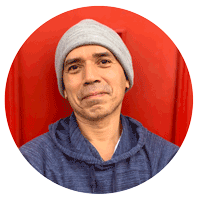Homelessness in NYC: A Shared Reality
Chances are you have walked by or shared a train car with someone who is homeless, know someone personally who has been homeless or even experienced homelessness yourself.
At The Bowery Mission, we are committed to standing with our New York neighbors in any kind of need. Last year nearly 8,000 people turned to our Red Doors for urgent help.

Every neighbor in need has a story.
Each person arrives at our Red Doors with their own struggles — some exhausted by endless setbacks, others scared for their safety, many shocked to find themselves homeless and most feeling completely alone. When crisis hit, they found themselves without a safe place or supportive community to turn to for help.

“I kept fighting, but I was losing hope. I didn't have any family to lean on.” — Michael

“I was trapped in a cycle of abuse — physically, mentally, and emotionally. I felt hopeless.” — Mayra

“Being unemployed and fighting cancer, I began to wonder how I would survive.” — Rafael
These NYC neighbors first came through our Red Doors in crisis and left testifying to God’s healing and redemption in their lives. Read their personal stories and many others.
The Need in NYC
Fast Facts
1.3 million+ New Yorkers are food insecure. That's about one in every six.
130,000+
people sleep in public shelters each night.
4,100+
people live unsheltered in the subways or on our streets.
1 in 5
low-income New Yorkers report living paycheck-to-paycheck.
2x National Rate
NYC’s poverty rate (23%) is nearly double the national average (12%).

Today, more people in NYC are experiencing homelessness than ever before.
- What causes homelessness?
In most cases, multiple factors are involved. Common ones include: mental illness, substance abuse, untreated medical issues, traumatic events, violence and abuse, lack of affordable housing and difficulty sustaining employment.
- Who experiences homelessness?
People of all genders, races, ages and socioeconomic backgrounds experience homelessness — including children. Sadly, many New Yorkers live on the razor’s edge, just one personal crisis away from homelessness.
- What are the effects of poverty on children?
Hundreds of studies have examined the detrimental effects of poverty on the well-being of children. Growing up in poverty may disturb a child's brain development and undermine his social and emotional growth.
- How can poverty be addressed?
Opportunities for enrichment and mentoring can play a critical role in helping children thrive in school and life. Quality programs support children's social and emotional development, helping them grow into adults who are healthy, grounded and economically self-sufficient.
- What do I do when I see someone in need?
Many men and women have received care at The Bowery Mission because someone stopped, reached out and let them know there was a place to get help. We invite you to check out our top tips for connecting with neighbors experiencing homelessness on our streets and subways. You can also download our resource card to invite them to The Bowery Mission for support.

Every life holds infinite value and untold promise.
That’s what our founders believed when they established The Bowery Mission on New York City’s Lower East Side in the 1870s. For over 150 years, we have provided a place of welcome, care and healing — a sense of home and family for those with nowhere to turn. Our Red Doors have always been open for a hot meal, a warm bed and a genuine conversation.
SOURCES: Coalition for the Homeless, data as of September 2024; NYC Homeless Outreach Population Estimate (HOPE), conducted on January 23, 2024; Hunger Free America; 6th Annual Poverty Tracker Report, published by Robin Hood and the Center on Poverty and Social Policy at Columbia University
PAGE LAST UPDATED: November 2024

